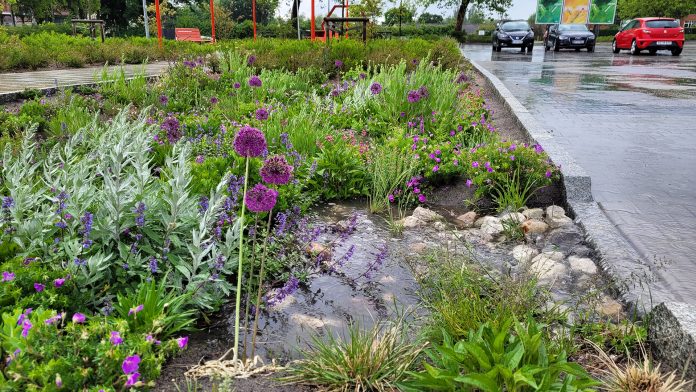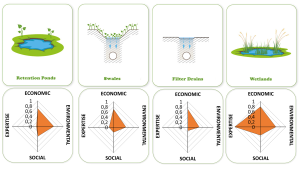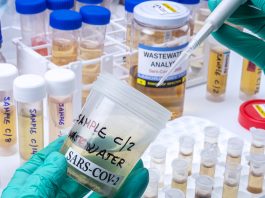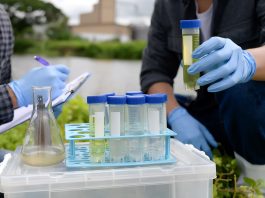D4Runoff is a Horizon Europe-funded project developing a novel framework to detect, prevent and reduce pollution in urban stormwater runoff.
Thousands of chemicals are used every day in urban areas, and many of them end up on surfaces in the urban landscape. When it rains in cities, the resulting urban stormwater runoff washes the surfaces and transports pollutants to the natural receiving waters, where they pose a risk to public health and damage to ecosystems.
In addition to heavy metals and other legacy pollutants, Contaminants of Emerging Concern (CECs), such as endocrine-disrupting compounds, pharmaceuticals and microplastics, are detected in urban runoff. However, regulation and monitoring programmes that aim to mitigate diffuse pollution cover only a small subset of contaminants. As a consequence, most municipalities and water companies have limited knowledge of which chemical compounds are present in the stormwater runoff.
The EU Green Deal includes the Zero Pollution Action Plan, in which the European Union has prioritised air, soil, and water pollution. The D4RUNOFF project, supported by Horizon Europe, develops a novel framework to detect and deal with urban runoff pollution by CECs.
The threefold D4RUNOFF approach
First, the project develops novel detection methods capable of providing a ‘chemical fingerprint’ for each water sample based on signals from known pollutants and unknown compounds that are not (yet) included in monitoring programmes. This will allow comparison of the chemical composition of urban runoff from cities across Europe and identify priority pollutants present in the samples.
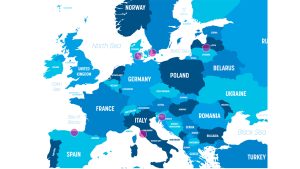
Next, we perform an analysis of sources, fate, as well as the effectiveness of present-day state-of-the-art Nature-based Solutions (NbS). Using GIS and AI tools emphasises the existence, importance and urgency of the ‘CECs problem.’ The project provides knowledge and tools to improve the accuracy and effectiveness of policies by providing detailed insights into the distribution and impacts of CECs across urban landscapes. By using real-time data and predictive analytics, D4RUNOFF helps to pinpoint areas most at risk and in urgent need of attention. This approach not only streamlines the regulatory process but also ensures that interventions are timely and based on sound science.
Secondly, D4RUNOFF remarks on the necessity/advantage of adopting NbS to mitigate the impact of CECs. By cataloguing effective NbS and pairing them with specific urban scenarios, the project aids decision-makers in choosing the most appropriate, sustainable, and cost-effective methods to prevent or reduce urban pollution.
Thirdly, D4RUNOFF advocates the integration of these solutions into local and national regulations, promoting a shift towards more resilient and environmentally friendly urban landscapes.
D4RUNOFF recommendations are likely to encourage policymakers to consider updating environmental regulations to incorporate continuous monitoring and proactive management of pollutants through technological control and natural mitigation means.
The research, innovating and engaging with policymakers and society is done in three case study cities: Odense in Denmark, Santander in Spain and Pontedera in Italy. In these case study areas, we will demonstrate the combined approaches and their effects, optimise the framework and provide guidelines for other cities and the EU Commission. The framework will be introduced in the municipal climate adaptation strategies, or it may even be leading the way to a concept for a municipal pollution strategy. These are all important steps forward to meet the Zero Pollution Action Plan.
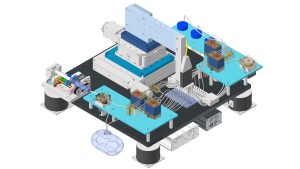
Improving knowledge optimise decisions: Detection and monitoring
Anthropogenic chemicals enter our urban environment through the use of building materials, vehicles, medicine, pet flea remedies, and many other sources. The introduction of new chemicals into our environment is a continuous process as the result of industrial innovation.
This prompts the scientific community to investigate. Analytical chemists race to keep track of these chemicals, while environmental scientists study how they move around and how they affect ecosystems. Exposure scientists investigate their interactions with living organisms. Meanwhile, potential health risks are assessed by toxicologists and epidemiologists.
Consequently, environmental engineers and policymakers work to manage, reduce and regulate chemicals in order to prevent and reduce pollution from urban stormwater runoff.
As innovation accelerates, this cycle becomes shorter. There’s an urgent need for a comprehensive assessment of the environmental cycle of emerging contaminants and a better understanding of key transport and fate mechanisms in order to minimise human exposure to their effects.
In order to make informed decisions regarding the status of runoff water and the performance of NbS, it is essential to provide the decision-makers with accurate and real-time data.
To do so, D4Runoff develops novel screening methodologies and automated instruments for in-situ monitoring of pollutants in runoff, including microplastics, pesticides, heavy metals and hazardous tyre wear chemicals. These devices are platforms integrating the latest technologies: microfluidics, nanomaterials, electrochemical and Raman sensors and advanced machine learning data analysis.
Overall, D4Runoff results put the holistic CEC lifecycle view into practice, from lab to action.
Applying Nature-based Solutions
In combination with NbS, conventional urban drainage systems can improve their capacity, efficiency, and lifespan, resulting in hybrid systems.
An exhaustive review of drainage techniques has resulted in the D4RUNOFF library, from which the parametric design of different NbS has been developed. These sustainable techniques have been prioritised with selected multi-criteria decision analysis (MCDA) methods, resulting in a ranking of NbS led by constructed wetlands and green roofs. The consideration of economic, environmental, and social criteria, together with the expertise in each technique, ensures the sustainability and viability of the final decision. The next step is to locate areas of opportunity for NbS using a Geographical Information System (GIS) that identifies the suitable places within the urban environment that meet the conditions for NbS implementation and proposes the best hybrid solutions for urban drainage in a given district.
Getting help from artificial intelligence
How can digital solutions and artificial intelligence (AI) revolutionise our ability to prevent runoff water pollution?
With D4RUNOFF’s innovative AI digital solutions, we are reshaping how the urban runoff is managed.
The innovation scope is to develop a smart platform that harnesses the power of cutting-edge technology and AI to connect the D4RUNOFF detection methods, sensors and risk mapping to prevent and reduce water pollution with NbS technology.
D4RUNOFF platform design will enable stakeholders to access the system accordingly. A green consultant, for example, can select the most effective NbS for each problem spot. At the same time, another section maps out pollution risks on the map, guiding the city managers to target the efforts where they are needed most. By collecting online data on pollutants and improving knowledge of pollution from different land uses and/or neighbourhoods of the city, the system can provide assistance to all stakeholders, including citizens, to be part of the solution by introducing NbS in their streets.
The Policy Making Support System helps city managers, and policymakers identify critical areas within the regulatory framework where interventions are needed to improve the monitoring of CECs and prevent pollution by promoting specific NbS in the urban planning and regulatory process.
The technical architecture of the D4RUNOFF platform seamlessly integrates technologies for efficient data processing, including the Calculation Engine and Data Gathering modules. These modules store crucial information and data from real sites across Europe. Together, they form a powerful tool, blending advanced science with tangible results for greener, cleaner cities.
Serving the EU’s Green Goals, Policy and Strategy: Diffuse pollution management
In line with the EU’s ambitious commitment to the Zero Pollution Action Plan and The EU Water Frame Directive, the D4RUNOFF project represents an innovative and forward-looking approach to urban pollution management.
The project aims to streamline the development and implementation of robust methods to assess the risks and costs of pollution and the benefits and drawbacks of solutions by developing novel chemical detection methods, monitoring, and forecasting tools.
Robust metrics are also essential to evaluating the legislative framework’s actual implementation, such as providing evidence to ban unnecessary chemicals and setting surveillance thresholds to promote prevention.
Foresight and knowledge: The core of D4RUNOFF
At its core, the D4RUNOFF project employs foresight as a method to enhance preparedness for the unexpected, particularly the challenges posed by climate change.
It delivers comprehensive knowledge of CECs, covering their sources, fate and transport, which can be used to identify priority pollutants that are not regulated today.
This knowledge serves as a valuable policy improvement tool, informing strategic decisions in environmental engineering and policy science. It embraces synergy and collaboration at multiple levels of institutional decision-making (EU, national, regional, and local) and multiple stakeholders (citizens, industry, authorities, etc.).
Indeed, the D4RUNOFF project does not operate in isolation. It is tightly linked to sister projects and crosscuts multiple targets set by policies.
D4RUNOFF outcomes go beyond the CEC and urban runoff: approach, knowledge, metrics, and tools will help enforce closely related strategies to tackle the complexities of efforts to reduce pollution in public services (a goal of the next EU Urban Wastewater Treatment Directive, UWWTD), and address the challenges of plastic and textile regulations and soil policy.
Through collaboration, the project promotes a holistic approach to the twin challenges of water quality and ecosystem health, emphasising the need for up-to-date knowledge and advanced metrics of contaminants.
Today’s urban wastewater systems, designed 30 to 60 years ago for a different era, are now facing the pressing demands of new requirements, like those set by the next UWWTD. The D4Runoff metrics and decision support tools provide helpful knowledge and foresight into next-generation UWWT technologies and strategies for massive renewal investment as those going to be mobilised by the €1tr European Sustainable Investment Plan for a climate-neutral economy.
D4Runoff tools also open up to better inclusion of just transition criteria to balance environmental goals with social agendas (of which NbS could be a cornerstone).
Conclusions
D4RUNOFF helps bridge the gap between technological advances and regulatory practice, influencing environmental regulation and policy-making through its scientific output, engaging key stakeholders at all levels of representation, and providing innovative decision-support tools to deal with diffuse pollution in urban stormwater runoff.
The scientific findings from the project’s chemical and biological research are bringing a ‘CECs problem’ to the fore.
By providing policymakers with accurate, data-driven evidence, the project will foster a proactive regulatory environment that prioritises ecological intelligence and facilitate the adoption of proactive, forward-looking regulations to include current and forthcoming CEC remediation into next-generation wastewater systems in our cities.
The intelligent tools to encourage the integration of NbS into planning and design on a day-to-day basis help to get more from investments for cost-effective reduction of pollution. These solutions are particularly important in areas where traditional infrastructure may not address the complex dynamics of stormwater runoff and pollutant dispersion, adding a social value.
In conclusion, D4RUNOFF project embodies the essence of the EU’s environmental strategy – informed by science, driven by policy and motivated by the vision of a healthier, more sustainable future for all.
Join us at d4runoff.eu to preserve our environment and safeguard our communities. Stay tuned for the coming groundbreaking results!
Please note, this article will also appear in the 18th edition of our quarterly publication.

